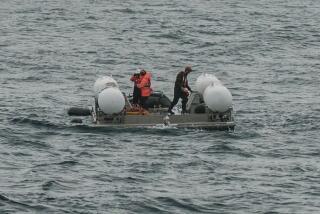All the Facts, Navy
- Share via
The Navy has acknowledged that two of the 16 civilian guests aboard its attack submarine Greeneville were sitting at key control stations last Friday when the sub surfaced directly under a Japanese fishing trawler, sinking that vessel in minutes with an apparent loss of nine lives. A Navy spokesman said the civilians were closely supervised but conceded that their presence alone might have distracted crew members assigned to the control stations. The Greeneville was practicing a rapid emergency ascent when the collision occurred. Why civilians were participating at all during an inherently dangerous operation awaits explanation. The Navy also ought to release the names of the invited guests who were aboard; not to do so smacks more of protecting the Navy than of protecting the guests’ privacy.
Japanese regard the sinking of the Ehime Maru, a training vessel for a fisheries high school, as only the latest in a series of confrontations involving U.S. armed forces.
Tensions run especially high on the southern island of Okinawa, where more than half of the 48,000 U.S. personnel in Japan are stationed. Crimes by military personnel against Japanese civilians, including rapes, arson and assaults, have deepened decades-old resentments over the number of Americans there and the large amount of land they occupy for training and maneuvers. On Wednesday, Foreign Minister Yohei Kono again raised the always sensitive question of revising the Status of Forces Agreement, which governs the management of U.S. bases in Japan. Japan wants its courts to have greater jurisdiction over Americans accused of crimes against Japanese.
President Bush has apologized to Japanese Prime Minister Yoshiro Mori over the sinking of the Ehime Maru. Officials at Pearl Harbor have condoled with the families of the missing three crewmen, two teachers and four students, and the Navy is looking into the feasibility of recovering the boat from where it sank in 1,800 feet of water nine miles off Hawaii. The proprieties have been observed. But many questions await answers in the dual investigations being conducted by the National Transportation Safety Board (NTSB) and the Navy. Properly, criminal charges are a possibility.
Of key importance is how much time elapsed between the submarine’s 360-degree periscope scan to make sure no ships were near where it would break the surface and its actual ascent. Also to be explained is what sonar the Greeneville used. In 1989, after investigating an accident involving a submarine and a civilian tug in the San Pedro Channel, the NTSB recommended that subs operating in American coastal waters use both active sonar, which bounces signals off other vessels, and passive sonar, which simply listens for sounds from other vessels. The Navy, which prefers to avoid active radar because it can reveal a sub’s position, refused to adopt the recommendation. Such thinking may be wise when operating in a hostile environment, but it seems a foolish limitation when a submarine is conducting drills in coastal waters.
The Greeneville obviously had no idea the boat lay in its path as it shot to the surface. But it should have known, and the investigators’ responsibility is to find out why it didn’t.
More to Read
Sign up for Essential California
The most important California stories and recommendations in your inbox every morning.
You may occasionally receive promotional content from the Los Angeles Times.













